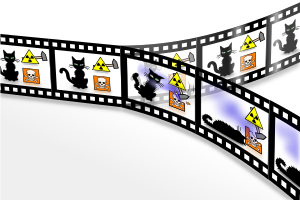
Back تفسير العوالم المتعددة Arabic Çoxlu dünyalar təfsiri Azerbaijani বহু-বিশ্ব ব্যাখ্যা Bengali/Bangla Viele-Welten-Interpretation German Teoriya xeylê cihanan DIQ Interpretación de los muchos mundos Spanish Paljude maailmade interpretatsioon Estonian دنیاهای چندگانه Persian Monimaailmatulkinta Finnish Théorie d'Everett French

| Part of a series of articles about |
| Quantum mechanics |
|---|
The many-worlds interpretation (MWI) is a philosophical position about how the mathematics used in quantum mechanics relates to physical reality. It asserts that the universal wavefunction is objectively real, and that there is no wave function collapse.[1] This implies that all possible outcomes of quantum measurements are physically realized in some "world" or universe.[2] In contrast to some other interpretations, the evolution of reality as a whole in MWI is rigidly deterministic[1]: 9 and local.[3] Many-worlds is also called the relative state formulation or the Everett interpretation, after physicist Hugh Everett, who first proposed it in 1957.[4][5] Bryce DeWitt popularized the formulation and named it many-worlds in the 1970s.[6][1][7][8]
In modern versions of many-worlds, the subjective appearance of wave function collapse is explained by the mechanism of quantum decoherence.[2] Decoherence approaches to interpreting quantum theory have been widely explored and developed since the 1970s.[9][10][11] MWI is considered a mainstream interpretation of quantum mechanics, along with the other decoherence interpretations, the Copenhagen interpretation, and hidden variable theories such as Bohmian mechanics.[12][2]
The many-worlds interpretation implies that there are most likely an uncountable number of universes.[13] It is one of a number of multiverse hypotheses in physics and philosophy. MWI views time as a many-branched tree, wherein every possible quantum outcome is realized. This is intended to resolve the measurement problem and thus some paradoxes of quantum theory, such as Wigner's friend,[4]: 4–6 the EPR paradox[5]: 462 [1]: 118 and Schrödinger's cat,[6] since every possible outcome of a quantum event exists in its own universe.
- ^ a b c d Everett, Hugh; Wheeler, J. A.; DeWitt, B. S.; Cooper, L. N.; Van Vechten, D.; Graham, N. (1973). DeWitt, Bryce; Graham, R. Neill (eds.). The Many-Worlds Interpretation of Quantum Mechanics. Princeton Series in Physics. Princeton, New Jersey: Princeton University Press. p. v. ISBN 0-691-08131-X.
- ^ a b c Tegmark, Max (1998). "The Interpretation of Quantum Mechanics: Many Worlds or Many Words?". Fortschritte der Physik. 46 (6–8): 855–862. arXiv:quant-ph/9709032. Bibcode:1998ForPh..46..855T. doi:10.1002/(SICI)1521-3978(199811)46:6/8<855::AID-PROP855>3.0.CO;2-Q. S2CID 212466.
- ^ Harvey R. Brown; Christopher G. Timpson (2016). "Bell on Bell's Theorem: The Changing Face of Nonlocality". In Mary Bell; Shan Gao (eds.). Quantum Nonlocality and Reality: 50 years of Bell's theorem. Cambridge University Press. pp. 91–123. arXiv:1501.03521. doi:10.1017/CBO9781316219393.008. ISBN 9781316219393. S2CID 118686956.
On locality:"Amongst those who have taken Everett's approach to quantum theory at all seriously as an option, it is a commonplace that—given an Everettian interpretation—quantum theory is (dynamically) local-there is no action-at-a-distance" on determinism:"But zooming-out (in a God's-eye view) from a particular branch will be seen all the other branches, each with a different result of measurement being recorded and observed, all coexisting equally; and all underpinned by (supervenient on) the deterministically, unitarily, evolving universal wavefunction"
- ^ a b Hugh Everett Theory of the Universal Wavefunction, Thesis, Princeton University, (1956, 1973), pp. 1–140
- ^ a b Everett, Hugh (1957). "Relative State Formulation of Quantum Mechanics". Reviews of Modern Physics. 29 (3): 454–462. Bibcode:1957RvMP...29..454E. doi:10.1103/RevModPhys.29.454. Archived from the original on 2011-10-27. Retrieved 2011-10-24.
- ^ a b DeWitt, Bryce S. (1970). "Quantum mechanics and reality". Physics Today. 23 (9): 30–35. Bibcode:1970PhT....23i..30D. doi:10.1063/1.3022331. See also Ballentine, Leslie E.; Pearle, Philip; Walker, Evan Harris; Sachs, Mendel; Koga, Toyoki; Gerver, Joseph; DeWitt, Bryce (1971). "Quantum-mechanics debate". Physics Today. 24 (4): 36–44. Bibcode:1971PhT....24d..36.. doi:10.1063/1.3022676.
- ^ Cecile M. DeWitt, John A. Wheeler (eds,) The Everett–Wheeler Interpretation of Quantum Mechanics, Battelle Rencontres: 1967 Lectures in Mathematics and Physics (1968)
- ^ Bryce Seligman DeWitt, The Many-Universes Interpretation of Quantum Mechanics, Proceedings of the International School of Physics "Enrico Fermi" Course IL: Foundations of Quantum Mechanics, Academic Press (1972)
- ^ H. Dieter Zeh, On the Interpretation of Measurement in Quantum Theory, Foundations of Physics, vol. 1, pp. 69–76, (1970).
- ^ Wojciech Hubert Zurek, Decoherence and the transition from quantum to classical, Physics Today, vol. 44, issue 10, pp. 36–44, (1991).
- ^ Wojciech Hubert Zurek, Decoherence, einselection, and the quantum origins of the classical, Reviews of Modern Physics, 75, pp. 715–775, (2003)
- ^ Schlosshauer, Maximilian; Kofler, Johannes; Zeilinger, Anton (August 2013). "A snapshot of foundational attitudes toward quantum mechanics". Studies in History and Philosophy of Science Part B: Studies in History and Philosophy of Modern Physics. 44 (3): 222–230. arXiv:1301.1069. Bibcode:2013SHPMP..44..222S. doi:10.1016/j.shpsb.2013.04.004.
- ^ Osnaghi, Stefano; Freitas, Fabio; Olival Freire, Jr (2009). "The Origin of the Everettian Heresy". Studies in History and Philosophy of Modern Physics. 40 (2): 97–123. Bibcode:2009SHPMP..40...97O. CiteSeerX 10.1.1.397.3933. doi:10.1016/j.shpsb.2008.10.002.
© MMXXIII Rich X Search. We shall prevail. All rights reserved. Rich X Search
